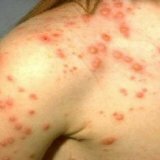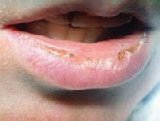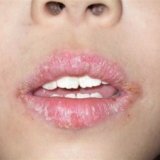Treatment and symptoms of chicken pox in children

Chicken pox or chicken pox is almost the most common disease that occurs in children. The treatment and symptoms of chickenpox in children are somewhat different from the same in adults, fortunately, in children the disease is much easier, so if a child gets chickenpox, then maybe this is for the best. After all, if he gets sick, when he grows up, everything can be much worse. The fact that chickenpox can only be treated once in a lifetime, after which the body produces lifelong immunity.
Methods of transmission of varicella: chickenpox transmitted by airborne droplets( through the mucous membranes of the respiratory tract and eyes).It is because of the peculiarities of its transmission that the disease got its name - chicken pox. Children who visit kindergartens or other pre-school establishments are much more likely to suffer from chickenpox. This is because among the children chickenpox is transmitted especially easily and if one child becomes ill, it can infect the entire group. The most frequent cases of chickenpox are children under the age of 10.As soon as you notice the symptoms of smallpox in children, you should immediately begin treatment, and in quarantine. However, in many developed countries, a child infected with chickenpox is not isolated and allows it to communicate with other children, because the illness in childhood is much easier.
Varicella becomes infectious the day before the skin rashes begin and the baby ceases to be the source of infection only on the fifth day after the last skin rashes appear. Usually quarantine is recommended to continue for 9 days from the time of the first rashes. But this does not always help, for the reason that chickenpox begins to be transmitted even before the appearance of the first rashes, that is, at a time when others are not aware of the developing disease.
Symptoms of
In children, as in adults, chicken pox does not show any symptoms from one to three weeks after infection. So long the incubation period of infection lasts. As soon as the incubation period is over, there is a sharp increase in temperature up to 39.5 degrees Celsius. And the disease would easily be confused with the usual, albeit somewhat difficult, if it were not for the appearance of a characteristic rash that does not take long to wait. Also, symptoms of chicken pox are weakness and headache, which, incidentally, can also be observed in ARI.
At first the rashes are not strong and are small, flat spots of pink color. But in a few hours their number is greatly increased. Gradually the spots take a convex shape, turning into bubbles. These bubbles can not be uncovered. In the first few days of the disease, the eruptions are abundant and appear on the skin and mucous membranes. In addition, they can not be scratched, despite the fact that it can be very itchy. When the bubbles pass, the skins remain on the skin, falling off independently after a while. If the treatment of chicken pox was correct, then there will be no traces of the disease on the skin.
Treatment of
When a child suffers from chickenpox, it should not be treated with antibiotics, as chickenpox causes the virus and antibiotics will only cause harm. Antibiotics can appoint a doctor and only if, in addition to chickenpox, the child develops a bacterial infection and suppuration of the vesicles occurs. Almost always, this happens because the child combs the rash and enters the infection into the wound, so it is extremely important to ensure that the child does not. To do this, you must distract it with all your strength. If the disease occurs without complications, then the treatment is done on an outpatient basis.
Symptoms of chicken pox for children may not be very severe and, nevertheless, one must try to convince the child to maintain bed rest for the time of illness. There is no medicine for chicken pox. But, fortunately, you can reduce the discomfort of the disease. To do this, you need to change clothes and bed linen of a sick person as often as possible and not to wet the rash, as this will only increase the itch and the life of the bubbles will be longer. As an exception, very short-term baths can be taken and a weak solution of manganese should be added to the water. In occasion of, whether it is necessary to take a bath at a chicken pox or it is better to refrain from it for the period of illness, the opinions of doctors differ. Some pediatricians believe that short-term bathing is necessary for sick children, while others recommend refraining from bathing for the time of illness. Drinking, on the contrary, should be abundant and the child must be provided with the necessary amount of liquid. Chicken pox in children can take a lot of energy and provoke a strong loss of appetite, in such cases, you need to figure out how to convince your child to drink more. Or give him to drink only what he wants.
At high temperatures, antipyretic agents are recommended, as well as in other diseases. If the temperature of the child rises above 38 degrees, you need to take this as a sign that it's time to think about lowering the temperature. Rash from chicken pox can not be smeared with alcohol, but can be green or a weak solution of manganese.
Consequences of chickenpox
If during the illness there was inflammation or suppuration of the vesicles, then after recovery, small scars may remain in their place.
Extremely rare with chickenpox develops really severe complications. But we can not help saying that sometimes there is inflammation of the brain, fortunately, such cases are incredibly rare.
The chickenpox of a newborn is of great danger, especially if a pregnant woman is infected with chickenpox, then there is a chance( about 17%) of the fact that the infection will be transmitted to the child. In such cases, a vaccine can be saved in time, which relieves the disease. Such vaccinations are made only to those people who have never had chicken pox.
In general, in almost all cases, chickenpox in children from year to year, with proper care, passes completely without a trace and without complications.



